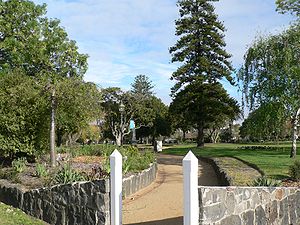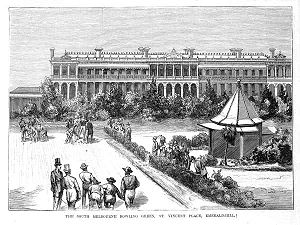
St Vincent Gardens, Melbourne
Encyclopedia

Melbourne
Melbourne is the capital and most populous city in the state of Victoria, and the second most populous city in Australia. The Melbourne City Centre is the hub of the greater metropolitan area and the Census statistical division—of which "Melbourne" is the common name. As of June 2009, the greater...
suburb of Albert Park, is an Australia
Australia
Australia , officially the Commonwealth of Australia, is a country in the Southern Hemisphere comprising the mainland of the Australian continent, the island of Tasmania, and numerous smaller islands in the Indian and Pacific Oceans. It is the world's sixth-largest country by total area...
n park of national significance.
It is an example of nineteenth century residential development around a large landscaped square. Development occurred as a result of a boom following the Victorian gold rush
Victorian gold rush
The Victorian gold rush was a period in the history of Victoria, Australia approximately between 1851 and the late 1860s. In 10 years the Australian population nearly tripled.- Overview :During this era Victoria dominated the world's gold output...
. It was influenced by similar, urban design in London, but such design on such a scale is unparalleled in Australia.
In the shape of a large rectangular area with semi-circular crescents at either end, the heritage area includes the St Vincent Place
St Vincent Place
St Vincent Place is a heritage precinct in Albert Park, Victoria, Australia.St Vincent Place is bounded by Park Street, Cecil Street, Bridport Street, Cardigan Place and Nelson Road. It is bisected by Montague Street, allowing the passage of trams on route 1...
precinct bounded by Park Street, Cecil Street, Bridport Street, Cardigan Place and Nelson Road. The park is bisected by Montague Street, allowing the passage of tram
Tram
A tram is a passenger rail vehicle which runs on tracks along public urban streets and also sometimes on separate rights of way. It may also run between cities and/or towns , and/or partially grade separated even in the cities...
s on route 1
Melbourne tram route 1
Tram route 1 is a public transport service in Melbourne, Victoria, Australia. It runs from the terminus at Nicholson Street and Bell Street in East Coburg to the corner of Victoria Avenue and Beaconsfield Parade in Albert Park....
. Several of the streets are lined with the original cobbled blue stone
Blue stone
Blue stone is a generic mineral description commonly applied to a variety of minerals. Perhaps the most common reference is to the hydrated copper sulfate mineral, chalcanthite. The name "blue stone" is also applicable to lazurite, the core constituent of lapis lazuli, a sulfide of sodium aluminium...
and gutters. It is registered with the National Trust of Australia
National Trust of Australia
The Australian Council of National Trusts is the peak body for community-based, non-government organisations committed to promoting and conserving Australia's indigenous, natural and historic heritage....
and on the Victorian Heritage register for its aesthetic, historical, architectural and social significance to the State of Victoria.
Significance

- as a reflection of the aspirations of middle class residents in South Melbourne. Because of the shared outlook on and use of the gardens, the precinct has developed a sense of community cohesion unusual in the Melbourne context. The gardens are also socially important as a focus of community life for the surrounding district with the maintenance of their amenity a priority of municipal government since their inception. The existence of the tennis and bowls clubs in the gardens for over a century is a further manifestation of this social importance.
The Australian Demographer Bernard Salt included the precinct as first among his "favourite places that have been designed by planners" :
- "St Vincent PlaceSt Vincent PlaceSt Vincent Place is a heritage precinct in Albert Park, Victoria, Australia.St Vincent Place is bounded by Park Street, Cecil Street, Bridport Street, Cardigan Place and Nelson Road. It is bisected by Montague Street, allowing the passage of trams on route 1...
, Albert Park: Where would such a list start but in my home city of Melbourne? Surely this residential precinct known only to Melburnians must be one of this nation's town planning treasures. Here are two extended but connecting crescents laid out around gardens which are overlooked by double-storey Victorian terrace houses. Designed in the early 1850s, St Vincent Place was virtually a gated community: the well-to-do would promenade around ``their public gardens; smaller wooden houses for servants and the working classes were relegated to the lesser enveloping crescents."
History

Clement Hodgkinson
Clement Hodgkinson was a notable English naturalist, explorer and surveyor of Australia. He was Victorian Assistant Commissioner of Crown Lands and Survey from 1861 to 1874.- Exploration in New South Wales :...
adapted the design in 1857 to allow for its intersection by the St Kilda railway line, Melbourne
St Kilda railway line, Melbourne
The St Kilda railway line is a former suburban railway in Melbourne, Australia.-Operation:The line was opened by the Melbourne and Hobson's Bay Railway Company in 1857...
.
Development of the gardens occurred during 1864-1870 with plans by Clement Hodgkinson in 1869 showing an overall plan of the reserve, including the older tree plantings, the path system at the western end and the circular theme of the paths design at the eastern end.
The Albert Park Bowls Club was established in the park in 1873.
The gardens were rejuvenated during 1903-1910 with much of the original landscaping being retained.
In 2004, a Canary Island Palm was removed suffering from fusarium wilt
Fusarium wilt
Fusarium wilt is a common vascular wilt fungal disease, exhibiting symptoms similar to Verticillium wilt. The pathogen that causes Fusarium wilt is Fusarium oxysporum . The species is further divided into forma specialis based on host plant.-Hosts and symptoms:The fungal pathogen Fusarium...
otherwise known as Panama Disease. In 2005 six significant trees were lost after a wild storm.
The improved appearance of the gardens over recent years has been due to local government projects required as part of a Conservation Management Plan (CMP). The creation of mulched beds around significant trees has improved their condition and large herbaceous beds have been restored using heritage plant stock. The most obvious works include the reconstruction of the western half of the path network along accurately plotted heritage alignments using the original orange-coloured, granitic, sand surface and steel edging. This included the installation of an on-site stormwater dissipation system, which now uses surface runoff to help irrigate lawn areas and minimise water usage. The perimeter hedge around the gardens uses original Lonicera heritage plant stock sourced from Dame Elisabeth Murdoch's 'Cruden Farm.' This hedge will grow to a height of approximately 700mm. The CMP and further detailed historical investigations have led to the design of entry treatments for each of the entrances to the Gardens. Composed of bluestone walls and timber posts, the new entrances have been accurately designed to closely resemble the original appearance and layout of the old entrances. Reconstruction of the entry treatments in the western half of the Gardens commenced earlier this year. The northern and southern border beds have been planted with heritage plant stock in accordance with planting designs prepared by Jill Orr-Young.
Plantings & Monuments
Plantings include lines of Algerian OakAlgerian Oak
Quercus canariensis, the Algerian Oak or Mirbeck's Oak is an oak in the section Quercus sect. Mesobalanus, native to southern Portugal, Spain, Tunisia, Algeria and Morocco; despite the scientific name, it does not occur naturally today in the Canary Islands, though it may have done in the...
(Quercus canariensis) and Canary Island Palm
Canary Island Date Palm
Phoenix canariensis is a species in the palm family Arecaceae, native to the Canary Islands. It is a relative of Phoenix dactylifera, the true date palm....
s (Phoenix canariensis).
There are specimen plantings of:
- Brush CherryBrush cherryThe magenta lilly pilly , also known by the common name magenta cherry, is a broad dense bushy rainforest tree native to New South Wales. It grows to a height of 15 m with trunk diameter up to 35 cm. Leaves are 3-9 cm long, opposite, simple and slightly obovate, tapering at the leaf base...
- Coral Tree
- Lilly Pilly
- Moreton Bay FigMoreton Bay FigFicus macrophylla, commonly known as the Moreton Bay Fig, is a large evergreen banyan tree of the Moraceae family that is a native of most of the eastern coast of Australia, from the Atherton Tableland in the north to the Illawarra in New South Wales, and Lord Howe Island. Its common name is...
- Norfolk Island Pine
- PeonyPeonyPeony or paeony is a name for plants in the genus Paeonia, the only genus in the flowering plant family Paeoniaceae. They are native to Asia, southern Europe and western North America...
- Southern magnolia (Magnolia grandiflora)
- Whitewillow
There is a monumental garden dedicated to the Australian entertainer Maurie Fields
Maurie Fields
Maurie Fields was an Australian actor, vaudeville performer and stand-up comedian. He became a well-known face on television thanks to his dramatic roles in Bellbird, The Box, Prisoner and The Flying Doctors...
, a former resident of the area.
The Charles Moore Memorial Drinking Fountain commemorates Charlie Moore
Charlie Moore (Australian rules footballer)
Walter Charles "Charlie" Moore was an Australian rules footballer who played for Essendon Football Club in the Victorian Football League , and who also served as a trooper in the Anglo-Boer War....
, a Boer War
Second Boer War
The Second Boer War was fought from 11 October 1899 until 31 May 1902 between the British Empire and the Afrikaans-speaking Dutch settlers of two independent Boer republics, the South African Republic and the Orange Free State...
soldier and Essendon Football Club
Essendon Football Club
The Essendon Football Club, nicknamed The Bombers, is an Australian rules football club which plays in the Australian Football League...
full forward. Moore was born 24 Sep 1875 in Fiji, married Rose Walters on 9 May 1898 at Fitzroy, Victoria (Vic reg 3227) and died 13 May 1901 at Doornbosch, South Africa
South Africa
The Republic of South Africa is a country in southern Africa. Located at the southern tip of Africa, it is divided into nine provinces, with of coastline on the Atlantic and Indian oceans...
.
The Alexander Rose Garden commemorates the contribution of Harold Alexander, Clerk of the City of South Melbourne from 1936-1964, who fostered munciipal welfare services.http://www.adb.online.anu.edu.au/biogs/A130527b.htm Under his administration, Australia's first 'community chest' for social welfare was set up. After the war, be bought Nissen huts to provide hot meals to returned servicemen. They were the forerunners of today's senior citizens clubs. Alexander appointed the council's first social worker and oversaw Australia's first meals on wheels service in 1953. He helped set up 'Claremont' aged care hostel. From 1927 he also fought to have Wirth's Circus site on Southbank reserved for the state's art gallery and cultural centre. He played for South Melbourne Football Club
Sydney Swans
The Sydney Swans Football Club is an Australian rules football club which plays in the Australian Football League . The club is based in Sydney, New South Wales. The club, founded in 1874, was known as the South Melbourne Football Club until it relocated to Sydney in 1982 to become the Sydney...
for five years.http://www.abc.net.au/melbourne/stories/s1571663.htm

